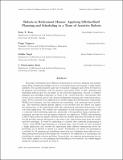| dc.contributor.author | Tran, Tony T. | |
| dc.contributor.author | Nejat, Goldie | |
| dc.contributor.author | Beck, J. Christopher | |
| dc.contributor.author | Stegun Vaquero, Tiago | |
| dc.date.accessioned | 2017-06-21T19:27:35Z | |
| dc.date.available | 2017-06-21T19:27:35Z | |
| dc.date.issued | 2017-03 | |
| dc.date.submitted | 2016-08 | |
| dc.identifier.issn | 1943-5037 | |
| dc.identifier.issn | 1076-9757 | |
| dc.identifier.uri | http://hdl.handle.net/1721.1/110151 | |
| dc.description.abstract | This paper investigates three different technologies for solving a planning and scheduling problem of deploying multiple robots in a retirement home environment to assist elderly residents. The models proposed make use of standard techniques and solvers developed in AI planning and scheduling, with two primary motivations. First, to find a planning and scheduling solution that we can deploy in our real-world application. Second, to evaluate planning and scheduling technology in terms of the ``model-and-solve'' functionality that forms a major research goal in both domain-independent planning and constraint programming. Seven variations of our application are studied using the following three technologies: PDDL-based planning, time-line planning and scheduling, and constraint-based scheduling. The variations address specific aspects of the problem that we believe can impact the performance of the technologies while also representing reasonable abstractions of the real world application. We evaluate the capabilities of each technology and conclude that a constraint-based scheduling approach, specifically a decomposition using constraint programming, provides the most promising results for our application. PDDL-based planning is able to find mostly low quality solutions while the timeline approach was unable to model the full problem without alterations to the solver code, thus moving away from the model-and-solve paradigm. It would be misleading to conclude that constraint programming is ``better'' than PDDL-based planning in a general sense, both because we have examined a single application and because the approaches make different assumptions about the knowledge one is allowed to embed in a model. Nonetheless, we believe our investigation is valuable for AI planning and scheduling researchers as it highlights these different modelling assumptions and provides insight into avenues for the application of AI planning and scheduling for similar robotics problems. In particular, as constraint programming has not been widely applied to robot planning and scheduling in the literature, our results suggest significant untapped potential in doing so. | en_US |
| dc.description.sponsorship | California Institute of Technology. Keck Institute for Space Studies | en_US |
| dc.language.iso | en_US | |
| dc.publisher | Association for the Advancement of Artificial Intelligence | en_US |
| dc.relation.isversionof | http://dx.doi.org/10.1613/jair.5306 | en_US |
| dc.rights | Article is made available in accordance with the publisher's policy and may be subject to US copyright law. Please refer to the publisher's site for terms of use. | en_US |
| dc.source | AAAS | en_US |
| dc.title | Robots in Retirement Homes: Applying Off-the-Shelf Planning and Scheduling to a Team of Assistive Robots | en_Us |
| dc.type | Article | en_US |
| dc.identifier.citation | Beck, J. Christopher et al. “Robots in Retirement Homes: Applying Off-the-Shelf Planning and Scheduling to a Team of Assistive Robots.” Journal of Artificial Intelligence Research (2017): n. pag. mEDRA. © Copyright 2017 AI Access Foundation, Inc. | en_US |
| dc.contributor.department | Massachusetts Institute of Technology. Computer Science and Artificial Intelligence Laboratory | en_US |
| dc.contributor.mitauthor | Stegun Vaquero, Tiago | |
| dc.relation.journal | Journal of Artificial Intelligence Research | en_US |
| dc.eprint.version | Final published version | en_US |
| dc.type.uri | http://purl.org/eprint/type/JournalArticle | en_US |
| eprint.status | http://purl.org/eprint/status/PeerReviewed | en_US |
| dspace.orderedauthors | Tran, Tony T.; Vaquero, Tiago; Nejat, Goldie; Beck, J. Christopher | en_US |
| dspace.embargo.terms | N | en_US |
| dc.identifier.orcid | https://orcid.org/0000-0002-4681-4363 | |
| mit.license | PUBLISHER_POLICY | en_US |
| mit.metadata.status | Complete | |
